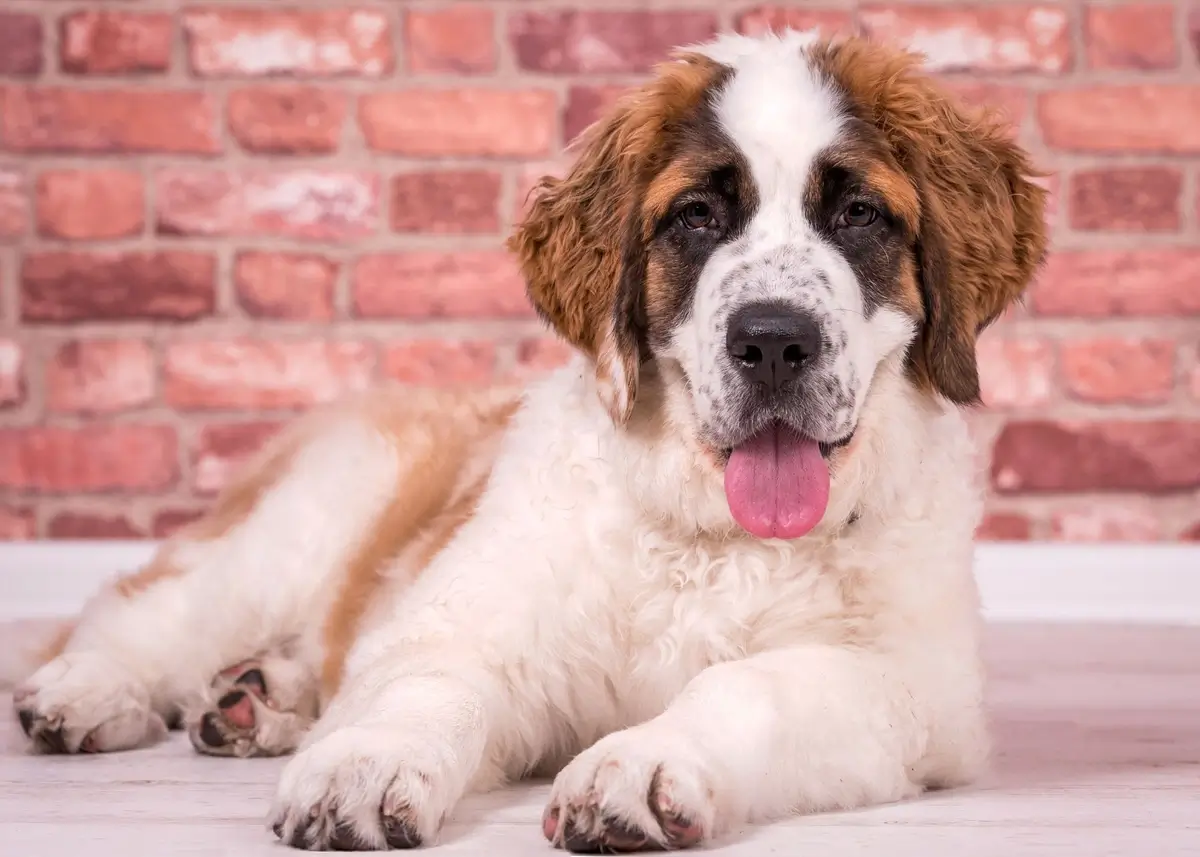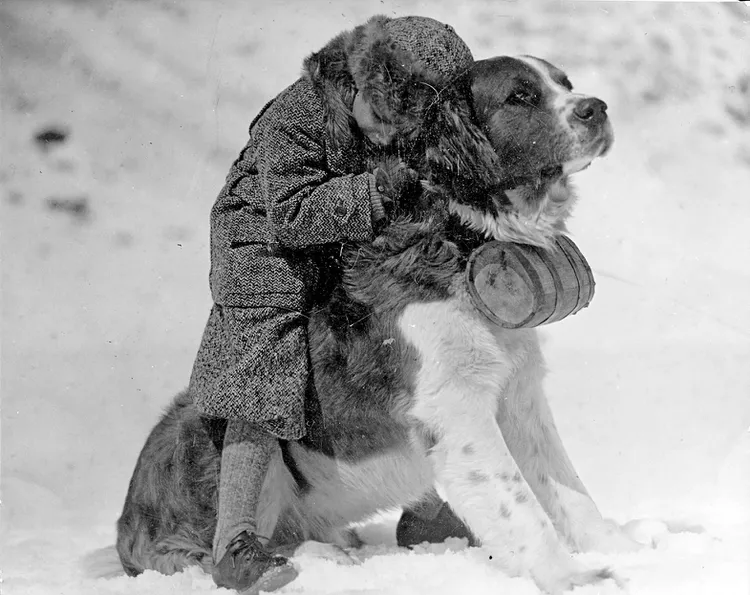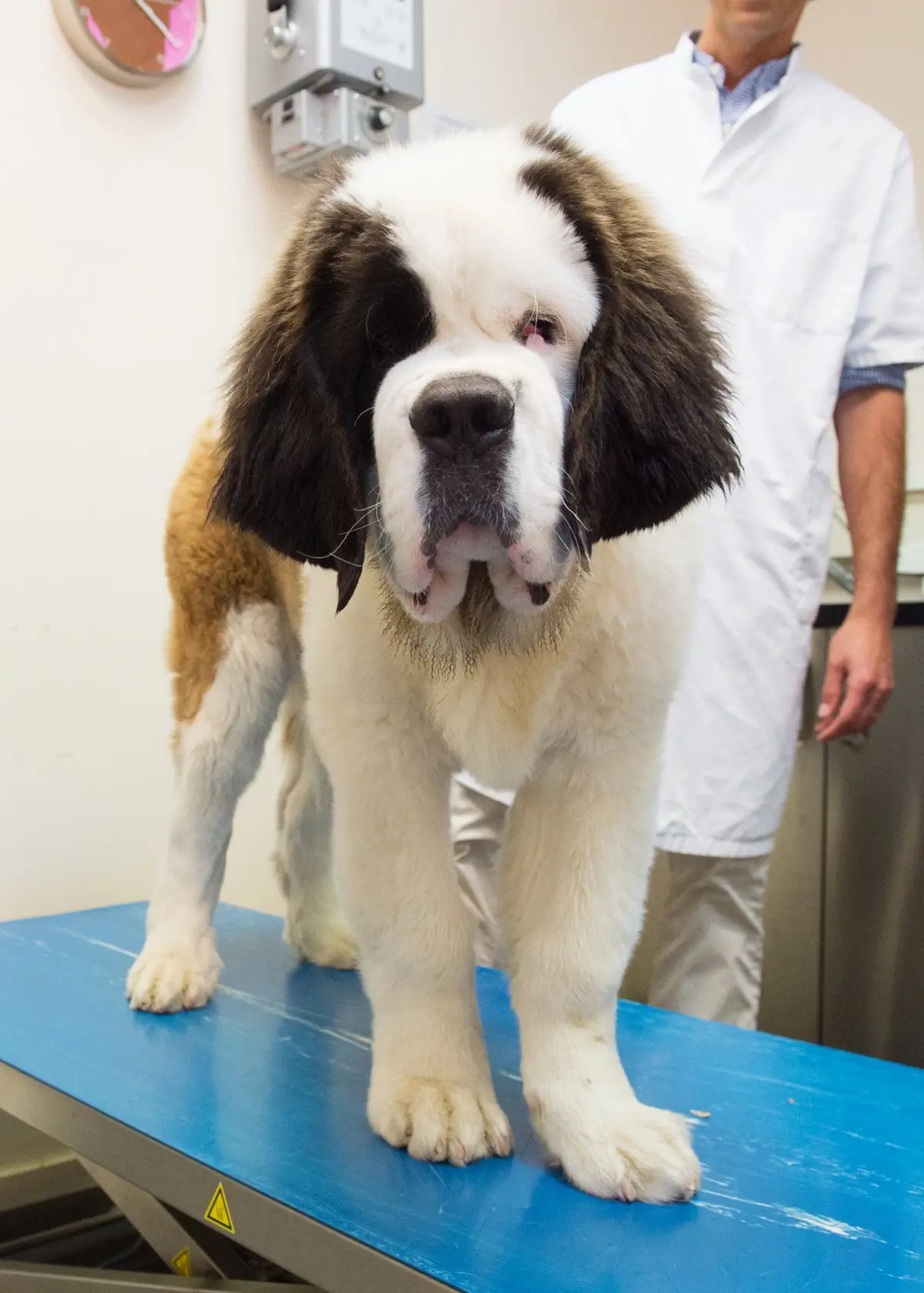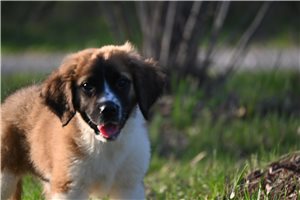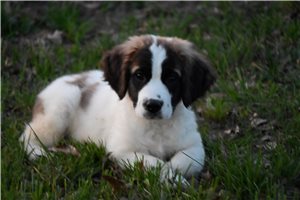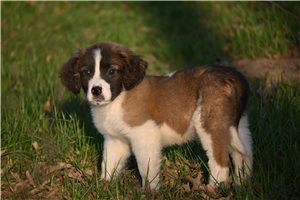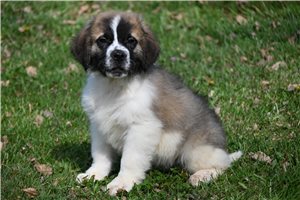You’re fighting in Napoleon’s army as one of 250,000 soldiers who must cross a treacherous Swiss alpine pass. All of a sudden, you see a white wall of snow rushing toward you. In an instant, you and your fellow soldiers are buried under a snowmass that feels like concrete. Luckily, there is a pocket of air that allows you to breathe.
“Yodel-lay-hee-hooo! Help, help! I’m trapped!” you meekly yell.
Eventually, you hear what sounds like digging above you. Giant paws claw at the snow, and you feel a huge, wet tongue licking you. When you’re free from the effects of the avalanche, you notice a gentle, furry giant sitting patiently by you waiting for you to be okay unbothered by the frigid temperatures. You take a swig of brandy from the little barrel around its neck to revive yourself and use some supplies in the pack.
Later at the hospice, a monk explains that a Saint Bernard was the dog that bravely rescued you. In fact, St. Bernards have been reported to have saved 2,000 people over 200 years.
Napoleon commands you to stand up and get moving again, but you’re just so cozy by the fire, amazed at the bravery and courage of this calm dog waiting for a pat on its massive head.
While they may look intimidating, Saint Bernard puppies are brave, majestic dogs that are gentle souls with compassionate spirits. You may see this dog breed’s name written as St. Bernard or Saint Bernard, and both are correct. Before they became known as Saint Bernards recognized by the Swiss Kennel Club in 1880 as their official name, they went by many names and were called mountain dogs, alpine dogs, hospice dogs, Swiss alpine mastiffs, and Saint Bernard mastiffs. Swiss people even called them Barry dogs after the famous St. Bernard named Barry we’ll learn about later on.
As members of the working group, St. Bernards are easily recognized, known for the iconic barrel of brandy or whiskey worn around their necks to revive avalanche victims. Whether or not they actually carried barrels is to be debated. The myth started from a painting in the 1840s depicting a St. Bernard with a barrel around its neck, but monks swear they never carried them. However, the barrel and St. Bernards go paw in paw as part of their lore, even depicted in pictures and photos of the national symbol and emblem of Switzerland.
However amazing St. Bernards may be, they do require special care that potential St. Bernard puppy owners will need to understand before this dog the size of a mini pony joins the family. Our guide will help you determine if a Saint Bernard puppy is the right dog breed for you.
The History and Origin of St. Bernard Puppies
Pilgrims, monks, and an enthusiastic breeder are to be thanked for the development of the Saint Bernard we know and love today. Pilgrims on a journey to Rome had to pass through the treacherous Swiss Alps between Italy and Switzerland, so a monk named Bernard de Menthon started a hospice to provide respite to weary travelers in the 11th century.
Saint Bernards were perfect working dogs up for the challenge. Their weather-proof coats, giant paws, remarkable sense of direction and smell, and friendly nature made St. Bernards invaluable.
Out of Napoleon’s 250,000 troops, it is reported that not a single soldier died of the “white death” thanks to St. Bernards’ rescue efforts. Travelers on pilgrimages to Rome and alpine adventurists also benefited from these hard-working dogs.
Heinrich Schumacher was an innkeeper who began breeding them in 1855 and kept careful pedigree records to perfect loyal, diligent St. Bernard puppies. He exported them to the US, England, and Russia where others began breeding them with mastiffs and Newfoundlands, creating the look we see today. Some Swiss versions remain with a shorter coat that doesn’t trap clumps of snow that weigh down the dogs like their longer-haired versions, but they’re the same breed regardless of hair length.
Barry the St. Bernard
One of the most famous St. Bernards of the 1800s was Barry der Menschenretter called Barry. Legend has it that Barry the St. Bernard saved 40 lives in his 14 years, and others know him as the dog that saved a half-frozen boy by carrying him on his back. Regardless of Barry’s feats, Barry now represents the iconic St. Bernard dog breed and is a national treasure.
St. Bernards today
While they don’t work in the Alps today due to a preference for smaller dogs that fit on rescue helicopters, the St. Bernard has found a new job also helping to save and improve lives. The Barry Foundation trains St. Bernards to serve as therapy dogs working in hospitals, nursing homes, autistic people, and children with psychosomatic trauma in over 50 locations in Switzerland.
Thanks to the movie Beethoven in 1990 and the seven sequel movies, the St. Bernard experienced a surge in popularity. However, many people got St. Bernards without carefully considering that dogs in the real world are very different from highly trained dogs for the silver screen. It is said that the movie Beethoven’s 2nd used nearly 100 puppies of the same age and size for continuity because they grow so incredibly fast.
Today, social media accounts document the hilarious, gentle nature of these magnificent beasts. They bring a special joy to owners who are up for the challenge of owning a St. Bernard.
What Do Saint Bernard Puppies For Sale Look Like?
We’ve already noted Saint Bernard puppies are massive, but let’s examine their stats further. These enormous dogs stand 26-30 inches tall and easily surpass the height of adults when standing on their hind legs. They will weigh 120-180+ pounds when fully grown. A St. Bernard is strong and muscular with a deep chest, sloping broad shoulders, broad backs, bushy legs, and a large, massive skull. Their furrowed, wrinkly brows, deep-set eyes, intelligent expressions, short muzzles, and droopy jowls give them a friendly, inquisitive look even if their bodies are imposing. A Saint Bernard’s paws are easily the size of small dinner plates.
Saint Bernards have a smooth, dense, waterproof short-haired double coat. Most people think they’re shades of brown on a white coat, but there are so many other colors and markings. They have a white coat with various colors including a white stripe down their faces, on their chests, and at the tips of their tails. White is mixed with mahogany, orange, brown, red, brindle, or rust with or without a black mask to create a beautiful, robust look.
What’s a St. Bernard Puppy's Personality Like?
When looking for a St. Bernard puppy, you’ll want to make sure his or her personality is a great fit for you and your family. Learn more about what St. Bernard puppy owners will tell you about this intriguing dog breed.
Always by your side
Living with a St. Bernard is like having a huge piece of Velcro stuck to your side. Rather than think of them as being clingy, frame it as they are so happy to be in your presence that they’d never dream of leaving you alone. St. Bernard puppies are never aloof or independent.
Affectionate and loving
Even though their giant presence may scare some people (hopefully any intruders), St. Bernards are very affectionate and form strong bonds with their family members. They’re always happy and will shower you (literally) with slobbery kisses. They have no concept of how large they actually are and will plop down in your lap looking for snuggles and hugs.
Live-in nanny
Nicknamed the “babysitter” or “nanny” dog, St. Bernard puppies and children are like two peas in a pod. They adore children and look after them with a strong sense of protection. St. Bernards are very patient with little ones. If raised together, St. Bernards are even friendly toward cats and other pets. As they do not have a prey drive.
However, St. Bernards have the potential to accidentally hurt small children due to their massive size, especially when playful. A swipe of a giant paw can scratch a child, and children can easily be knocked over during rough playtime. For this reason, you must supervise your St. Bernard puppy during play to keep everyone safe.
Great watchdogs
There’s not an aggressive bone in their big bodies, but St. Bernards make excellent watchdogs. Their protective nature will alert you to anything amiss. While they won’t attack, their sheer size alone is enough to deter even the most nefarious criminals and have them think twice about choosing your home as a target. St. Bernards are not frequent barkers, but when they do, it rings deeply and loudly.
Bless this mess
Some dogs clean themselves like cats and prefer to be tidy. A St. Bernard, however, is not one of these dogs. We’re obligated to discuss the amount of drool you’ll experience as a St. Bernard puppy owner. Because their mouths hang down, they drool a lot, especially when they’re hungry, excited, hot – or just because! St. Bernard owners recommend keeping a dedicated slobber towel around to wipe up the drool that will end up everywhere, and be sure to keep an arsenal of enzyme and upholstery cleaners handy to keep your inside free of drool.
Hold your nose
To put this delicately, be prepared for the silent-but-deadly gas and the ones that make you hold your nose while belly laughing at the hilarious noises that come out of a St. Bernard. They can have sensitive stomachs, and the whole house (and maybe even the neighbors) will be able to tell! Make sure you’re feeding them a high-quality diet to reduce gas.
Caring For Your St. Bernard Puppy For Sale
Because Saint Bernard puppies are unlike most small or medium-sized dogs, they require special care that you need to know about before becoming a St. Bernard puppy owner to ensure you are prepared to give them a great life of the 8-10 years they’re with you.
Cold weather lovers
As one of the best cold weather dog breeds, St. Bernards thrive in frigid climates. They are happy to bury themselves in snow drifts and try to catch your snowballs. They may not even want to come inside to sit by a fire because they’re simply having too much fun. If you do let your St. Bernard puppy outside in frigid temperatures, make sure to follow safety tips for dogs in cold weather.
If you live in a hot climate, consider a dog more suited for that weather. Otherwise, take precautions to make sure your St. Bernard does not get overheated or dehydrated in hot weather to keep them safe and comfortable.
Exercise and activity level
A St. Bernard can be known as a lazy couch potato, but they do enjoy about 30 minutes of activity a day to stay healthy. Avoid strenuous activities till age two because their bones take longer to grow. St. Bernards love taking their time on slow walks, so a scent walk is perfect for them to sniff around and check things out. You can never be in a hurry with a St. Bernard!
Training your St. Bernard puppy for sale
While not topping the list of nature’s most intelligent dog breeds, they aren’t dumb, either. These gentle giants are eager to please and do best with short training sessions using positive reinforcement and lots of praise due to their gentle nature.
You’ll get a lot of attention when you’re out and about with your St. Bernard puppy, so you must socialize your puppy to go with the flow when strangers approach.
Consider crate training at a young age to associate it with a positive place. Humans also need to be trained on living with big dogs just as much as your big dog needs training. Keep sessions short since they tire out quickly but they really do want to please you.
If you don’t establish proper training as early as possible, your St. Bernard puppy could be a liability. He could hurt people even being affectionate - one paw swipe to keep petting them could scratch someone, and jumping up could take out a full-size adult, let alone a child. Teach your St. Bernard puppy good manners. They truly don’t understand how big they are.
Be financially prepared
When you are a St. Bernard puppy owner, everything will be more expensive than owning a small or medium-sized dog. The bigger the dog, the more money you will be spending on items like crates, cars to transport them, a home with enough inside and outside space, paying their medical bills, feeding them, and keeping up with preventative medicines and vaccinations. Truly crunch the numbers to be financially prepared to own a St. Bernard puppy to care for it throughout its entire life.
A St. Bernard has heavy grooming needs
St. Bernards are moderate-to-heavy shedders that blow their coats twice a year, usually in the spring and fall. You’ll need to keep a variety of dog brushes for DIY grooming at home when you are a St. Bernard puppy owner. Brush them three times a week to remove loose hair, detangle mats, and remove dirt and debris. Bathe only when necessary to avoid dry, itchy skin due to stripping the natural coat oils away.
When you do bathe them, use a deshedding shampoo and conditioner. After blow drying, use a wire brush, undercoat rake, metal comb, and a dematting tool for under the belly, sanitary area, under the arms, and under the ears to keep them looking fresh and tangle-free.
Potential medical issues
You may have noticed St. Bernard puppies have eyes that may not look like the eyes of dogs that you’re used to seeing. Ectropion in St. Bernards is an abnormality causing the bottom eyelids to become inverted, exposing delicate tissue that lines the inner surface of the eyelids and covers the eyeball. It can dry out tissue, resulting in conjunctivitis and other eye problems. St. Bernard puppy owners can correct the condition with surgery if it is severe or treat their eyes with lubricant.
Due to their massive bones, St. Bernards can experience painful growth spurts. They can also suffer from bone cancer, bloat, and hip and elbow dysplasia. You can take action to prevent health issues with regular vet care, preventative medicine, proper dental care and grooming, and being in tune with your St. Bernard puppy.
Where Can I Find Saint Bernard Puppies?
If you’re looking for St. Bernard puppies, you may have a difficult time finding one. You may be tempted to pursue the first opportunity you find on social media sites or signs by the side of the road. However, you’re burying yourself in an avalanche of potential scams, backyard breeders, or puppy mill puppies.
The best course of action is to turn to Pawrade, where we have a 100% no-puppy mill pledge and hate puppy scams as much as you do. We have an extensive network of trustworthy St. Bernard puppy breeders who love their dogs as much as you do and want them to go to good homes. Every St. Bernard from our reputable breeder partners comes with a 30-day MetLife insurance policy, a 3-year health guarantee, up-to-date vaccinations, a puppy contract, relevant paperwork, and more. To give you peace of mind, every transaction is conducted through a secure payment management system.
We can’t wait to help you pick out St. Bernard puppies for sale. Let us know which gentle giant you prefer, and we’ll help you every step of the way.
